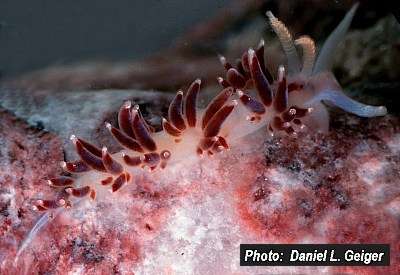
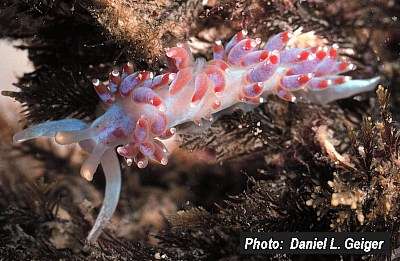
Facelina auriculata
(Müller, 1776)
Order: NUDIBRANCHIA
Suborder: AEOLIDINA
Family: Glaucidae
DISTRIBUTION
Mediterranean and east Atlantic north to Norway.
PHOTO
Banyuls sur Mer, Mediterranean coast, France. 1992. Two animals showing how change of food colour (in ceratal digestive gland) can change appearance. PHOTOS: Daniel L. Geiger.
Reference:
• Müller, O.F. (1776). Zoologiae Danicae. Prodromus seu animalium Daniae et Norvegiae ingenarum characteres, nomina et synonyma impris popularium: p. I-XXXII, 1-282
NOTE: Facelina coronata (Forbes & Goodsir, 1839) is a synonym of Facelina auriculata. See Bernard Picton's message. Until 30 August 2001 the name F. coronata was used on the Forum.
Characterised by the lamellate rhinophores and the first ceratal cluster being well separated from the rest of the cerata. The red oesophagus, is usually visible through the body wall, just behind the rhinophores [it can be seen clearly in Frank Gloystein's lower photo]. It is quite variable in colour but there is often a bluish sheen on the head and the cerata, and a whitish streak on the upper half of the rhinophores and the tips of the oral tentacles. Grows to about 50 mm and feeds on variety of hydroids.
Note added 15 May 2009: See Greg Brown's message [#22494] with photos comparing F. auriculata with F. bostoniensis.
Authorship detailsRudman, W.B., 1999 (June 5) Facelina auriculata (Müller, 1776). [In] Sea Slug Forum. Australian Museum, Sydney. Available from http://www.seaslugforum.net/find/faceauri
Related messages
Re: Facelina auriculata from the French Mediterranean
May 6, 2010
From: Jean Michel Crouzet
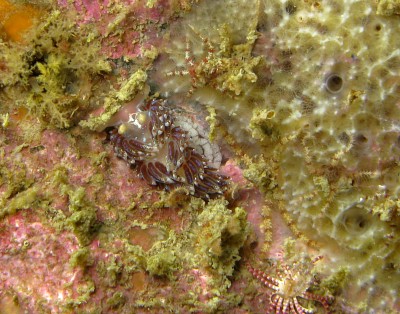
Concerning message #23424:
Hello,
I live in Bretagne. Here is a photo of Facelina auriculata laying its eggs.
Locality: Vallon du cheval Ile de Groix, 8 métres, Bretagne, France, Atlantic Océan, 15 april 2010. Length: 15 mm. Photographer: Jean Michel Crouzet .
Jean Michel Crouzet
jean-michel.crouzet56@orange.fr
Crouzet, J.M. , 2010 (May 6) Re: Facelina auriculata from the French Mediterranean. [Message in] Sea Slug Forum. Australian Museum, Sydney. Available from http://www.seaslugforum.net/find/23508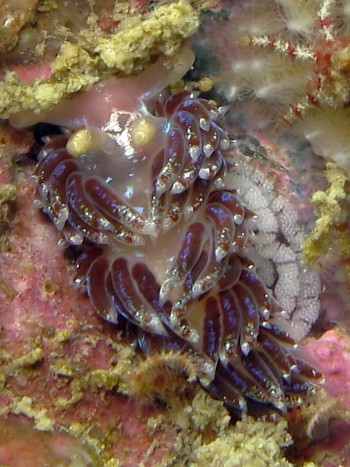
Thanks Jean Michel,
Well spotted - despite being brightly coloured, small nudibranchs are often very difficult to see in their natural habitat.
Best wishes,
Bill Rudman
Facelina auriculata from the French Mediterranean
April 14, 2010
From: Dominique Horst

Hi Bill,
I think this is Facelina auriculata. This is the first time I have seen it in the Mediterranean sea.
It seems frequent in Banyuls, but I've never seen it before anywhere else.
Locality: Banyuls, 9 m, France, Mediterranean sea, 26 March 2010. Length: 18 mm. Photographer: Dominique Horst.
Kind regards,
Dominique
dominique.horst@wanadoo.fr
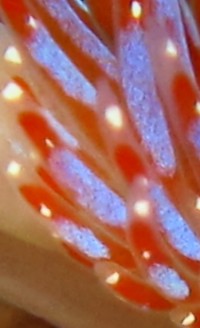
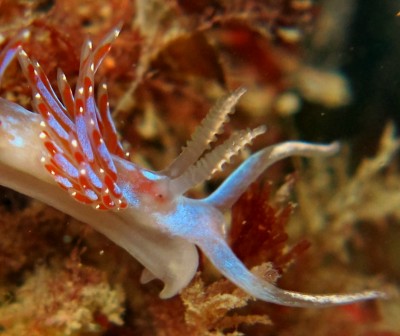
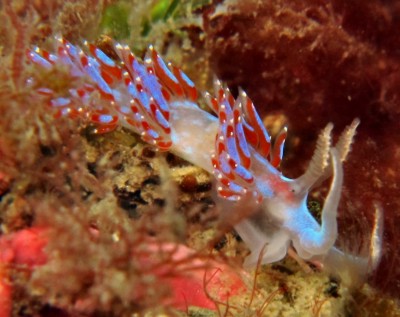
Dear Dom,
This is an appropriate message to post at the same time as Miquel Pontes' message on colour in this species [see #23479] As I suggest in his message, the granular nature of the blue patch, which we can see in your close-up, suggests that the colour may be structural rather than a pigment.
I can also see a small Cuthona caerulea in the top photo.
Best wishes,
Bill Rudman
Re:F. coronata or F. auriculata? from Spain
April 14, 2010
From: Miquel Pontes
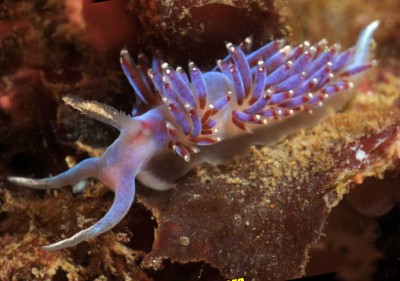
Concerning message #4854:
Hi Bill,
We came across this interesting specimen of Facelina coronata which, according to some of the documentation available to us, was cited as Facelina auriculata. It was clear, after the forum message by Bernard Picton, that these two species are indeed the same.
I wanted to send you my pictures because it seems this Spanish F. auriculata has a brighter blue coloration than other pictures from other places published here, obviously this has some correlation with this animal feeding.
Locality: Aiguafreda, Begur, Costa Brava, 12 metres, Spain, Mediterranean Sea, 10 April 2010, Rocky bottom covered with calcareous algae. Length: 30 mm.. Photographer: Miquel Pontes.
Best regards,
Miquel Pontes
miquelpontes@gmail.com
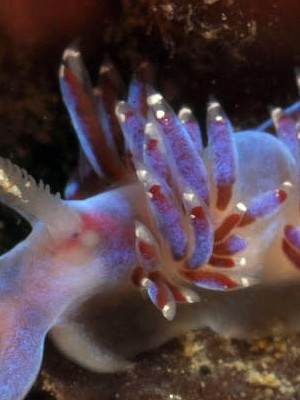
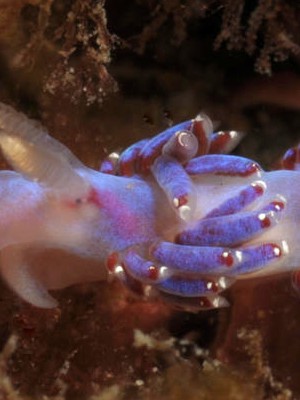
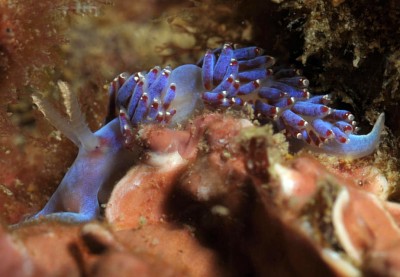
Thanks Miquel,
I think the blue colouration is a surface skin colour and so is unlikely to be directly related to their food. Certainly the red colouration is food related because we can see that the digestive gland ducts in the cerata are red. In the close-ups I have included we can also see the oesophagus through the body wall, just behind the rhinophores, stuffed full of red 'food'. The close-ups also show how the blue patches are just on the outer side of the cerata and that they obscure the view of the red digestive gland.
It's probable that the blue is not in fact a pigment but rather a 'structural' colour caused by something in the skin cells which is reflecting or bending some light waves. In some species, such as Pteraeolidia ianthina, the blue or opalescent colour colour appears more intense when the ceratal contents are a darker colour. Perhaps the dark red digestive gland contents in your animal makes the blue more intense, or it could be related to the the angle of the light hitting the aeolid when you photographed it.
Best wishes,
Bill Rudman
Facelina ? from French Mediterranean coast
August 21, 2008
From: Sylvain Le Bris
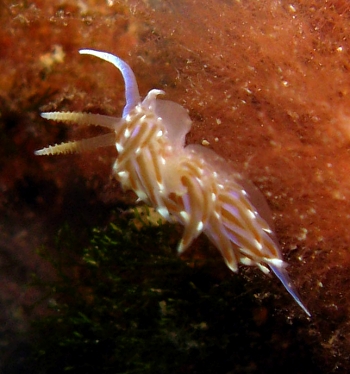
Dear Bill,
I couldn't succeed to identify this Facelina. Is it F. bostoniensis or F. albida or F. auriculata? or another species !
Locality: Marseille, 15 m, France, Mediterranean sea, 28 June 2008. Length: 2.5 cm. Photographer: Sylvain Le Bris.
Thanks for your help
Kind regards
Sylvain
lebris.sylvain@gmail.com
Le Bris, S., 2008 (Aug 21) Facelina ? from French Mediterranean coast. [Message in] Sea Slug Forum. Australian Museum, Sydney. Available from http://www.seaslugforum.net/find/21794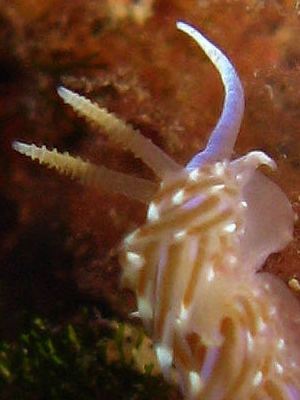
Dear Sylvain,
This is Facelina auriculata. It has similarities to F. bostonensis but in F. auriculata the cerata are shorter, and in distinctly separate clusters. Also, the cerata usually don't extend beyond the posterior tip of the foot. Another character is that F. auriculata always has the blue streaks on the cerata which are absent in F. bostonensis.
I am not sure what you mean by F. albida?
Best wishes,
Bill Rudman
Facelina auriculata from Plymouth, UK
August 14, 2006
From: Judith Oakley

Bill
These photos were taken in the Mayflower Marina recently. I hope that my ID is correct and that they are Facelina auriculata?
Locality: Mayflower Marina, Plymouth and QAB, Plymouth, UK, 07 August 2006, On kelp on marina pontoon. Length: 1.7cm. Photographer: Judith Oakley.
Best regards
Judith
jomoakley@btinternet.com
Oakley, J.A., 2006 (Aug 14) Facelina auriculata from Plymouth, UK. [Message in] Sea Slug Forum. Australian Museum, Sydney. Available from http://www.seaslugforum.net/find/17387
Dear Judith,
At the risk of being over confident with a species I have only seen once or twice alive, many years ago, I am sure this is F. auriculata. The annulate rhinophores, the red oesophagus just behind the rhinophores, and the blue bands on the cerata are all characteristic of this species.
Best wishes,
Bill Rudman
Facelina auriculata from Cork, Ireland
June 15, 2006
From: Jamie Malone
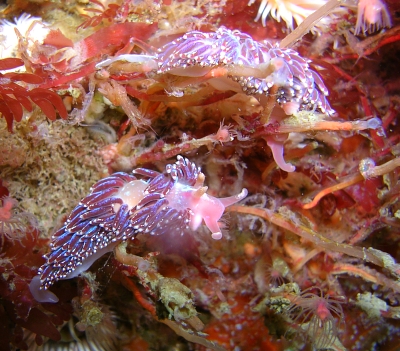
Dear Bill
Here is another one I can't identify.
Locality: Fastnet Light house , 6 metres, west Cork , Fastnet, Ireland. 04 June 2006, rocky shore line . Length: 40 mm. Photographer: Jamie Malone .
Jamie Malone
malonejamie@hotmail.com
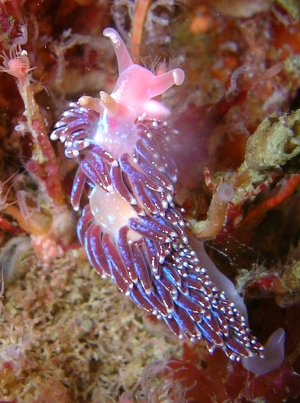
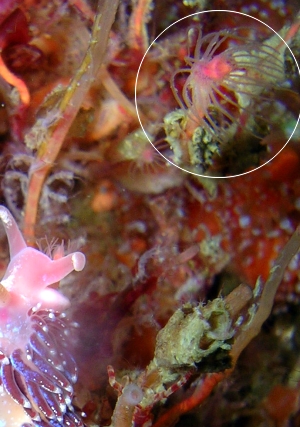
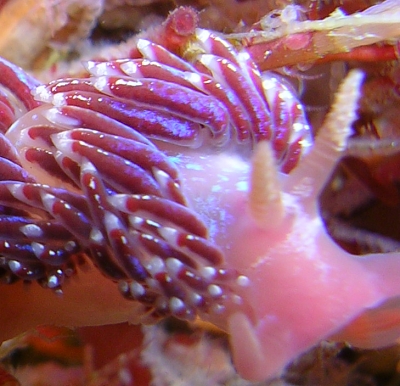
Dear Jamie,
This is the same aeolid, Facelina auriculata, which I indentified for you in an earlier message [#16497]. This one is a bit more typical in its colour pattern with distinctive blue streaks down the cerata. It is eating the same hydroid, Tubularia, in this message, but seems to have had a bigger impact on the colony, with few hydroid polyps remaining.
Best wishes,
Bill Rudman
Facelina auriculata, in Brittany
June 13, 2006
From: Stephane Ores

Dear Bill
I saw this morning, in northern Brittany, France (St Cast Le Guildo) this nudi on a alga.
Locality: St Cast, northern Brittany, France, 8 m, France, Channel, 05 june 2006, Good visibility. Length: 20 mm. Photographer: Stephane Ores.
Is it Facelina auriculata?
Thanks a lot Bill
Best regards
Stephane
stephane.ores@neuf.fr
Ores, S., 2006 (Jun 13) Facelina auriculata, in Brittany. [Message in] Sea Slug Forum. Australian Museum, Sydney. Available from http://www.seaslugforum.net/find/16811Dear Stephane,
Yes this is Facelina auriculata
Best wishes,
Bill Rudman
Facelina auriculata from Ireland
May 2, 2006
From: Jamie Malone .

Here's a couple of nudibranch pictures I took on a dive in Waterford , Ireland yesterday
Locality: Ballymacaw, 4 meters, Waterford, Iireland, Celtic sea , 30 april 2006, high tide vis 2-3 meters. Length: 20 / 30 mm. Photographer: Jamie Malone .
Jamie Malone
malonejamie@hotmail.com



Dear Jamie,
It's a pity that the beauty of some of these small nudibranchs can only be seen with a microscope or macro lens on a camera. This aeolid,Facelina auriculata . It is crawling on one of its favourite food items, the hydroid Tubularia indivisa. These flower-like animals have stinging cells (nematocysts) in the ring of tentacles around their mouth for catching their prey. They also use them to ward off attackers, like the aeolids. However when their defenses fail and they are eaten by the aeolids, the nudibranchs store the stinging cells in their own bodies for reuse. Have a look at the cnidosac Fact Sheet for some background information.
Best wishes,
Bill Rudman
Re: Flabellina pedata? from UK
September 30, 2005
From: Bernard Picton
Hi Bill,
Concerning message #14537:
Just having a look through the Forum I came across Judith's message. Your identification is correct and Facelina auriculata does lay eggs which look like this.
Bernard
bernard.picton@magni.org.uk
Picton, B.E., 2005 (Sep 30) Re: Flabellina pedata? from UK. [Message in] Sea Slug Forum. Australian Museum, Sydney. Available from http://www.seaslugforum.net/find/14870Thanks Bernard,
Bill Rudman
Flabellina pedata? from UK
August 12, 2005
From: Judith Oakley
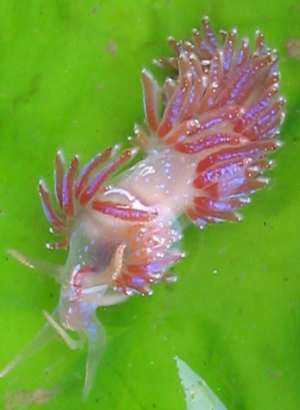
Dear Bill,
On another marina safari today, I found this very attractive sea slug. I was predominantly pink/purple colour. It was on Ulva lactuca with bryozoans and hydroids. Also this spawn was nearby. Can you help with ID of the sea slug and the eggs (I wonder if the eggs are those of Janolus cristatus?).
Locality: Queen Anne's Battery marina, Plymouth, Devon, UK. Length: 16 mm. 10 August 2005. marina pontoon on Ulva lactuca. Photographer: Judith Oakley
Thank you
Judith Oakley
kf1@mba.ac.uk
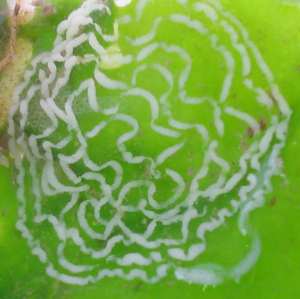
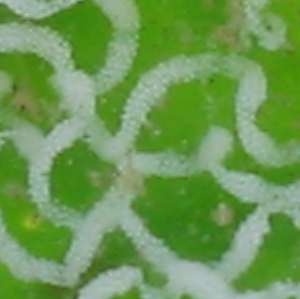
Note added 13 July 2007: These are not the eggs of J. cristatus but see message #20089 showing apparent eggs in Janolus cristatus are in fact capsules containing many eggs.
Dear Judith,
I am pretty sure this is Facelina auriculata. The red ceratal digestive gland, the red oesophagus which can be seen between the rhinophores, the lamellate rhinophore clubs with a white streak up the front of the club, are all characteristics of this species.
Concerning the egg ribbon. It is possible it belongs to your Facelina, but I don't know what shape egg ribbon it has. It is definitely not that of Janolus cristatus. If you have a look at an earlier message [#1285], there is a photo of its egg ribbon, and although it has the same general shape, the individual eggs are relatively large and form a single row in the ribbon. In your egg ribbon the eggs are small and are in a multiple arrangement.
Best wishes,
Bill Rudman
Facelina auriculata from sthn England
May 7, 2005
From: Jack Sewell
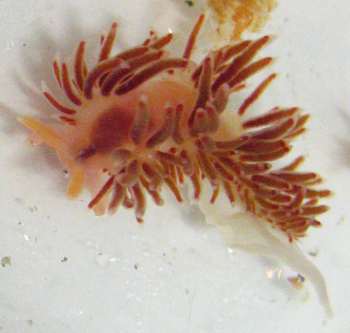
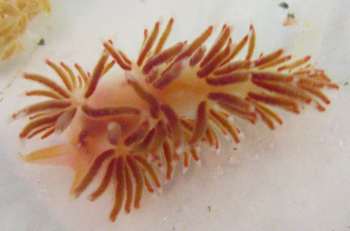
Hi.
This attractive nudibranch was found on the recently sunk HMS Scylla on the south coast of England. In March this year we are unsure of the species. Could have been Facelina or Coryphella. The specimen measured approximately 2 cm in length. rhinophores were annulate and I think the other features are apparent in the pictures.
(There are also 2 smaller individuals also shown in the picture, but I think identification of these would be difficult if not impossible from these images due to the size!)
Locality: Wrech of HMS Scylla, offshore near Plymouth, Devon/Cornwall, England. English Channel. Depth: 20m +. Length: 2 cm. March 2005. on wreck of frigate (war ship) Photographer: Jack Sewell.
Jack Sewell
jase@mba.ac.uk
Sewell, J., 2005 (May 7) Facelina auriculata from sthn England. [Message in] Sea Slug Forum. Australian Museum, Sydney. Available from http://www.seaslugforum.net/find/13714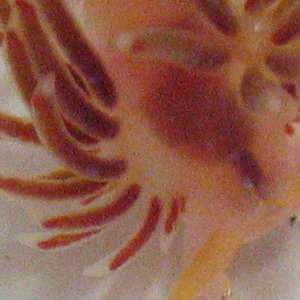
Dear Jack,
Form your mention of lamellate rhinophores, the arangement of the cerata and the scattered iridescent blue spots on the body and cerata, I think this is Facelina auriculata, but I would like soem confirmation - or a better answer - from someone more familiar with the north Atlantic fauna.
Best wishes,
Bill Rudman
Facelina auriculata from Brittany
September 7, 2002
From: Marina Poddubetskaia

Dear Bill,
Bernard Picton has identified this aeolid for me as Facelina auriculata
Date: August 16, 2002
Location: Belle-ile, Brittany, France, Atlantic Ocean coast.
Site: Penhouet
Depth: 8m
Size: 10-15mm
Photos: Marina Poddubetskaia - Nembro website
Best wishes,
Marina.
nembro@nembro.info
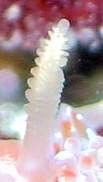

Thanks Marina,
Bill Rudman
Facelina auriculata from Scotland
August 31, 2001
From: Jim Anderson
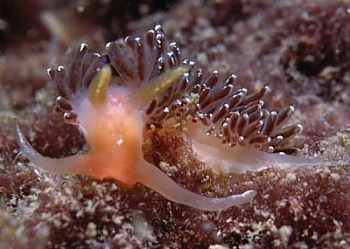
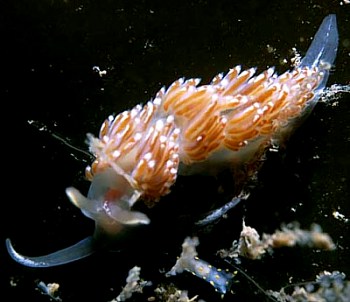
Dear Dr. Rudman,
These two animals were photographed on the same dive on 19 August 2001 at Godag reef off the island of Muck in the Inner Hebrides here in Scotland. The water temperature was 13 deg C.
UPPER PHOTO: found at the base of the kelp at 10 metres
LOWER PHOTO with tiny Polycera quadrilineata on a kelp blade at 6 metres.
Kind regards,
Jim Anderson
jander4454@aol.com
Anderson, J., 2001 (Aug 31) Facelina auriculata from Scotland. [Message in] Sea Slug Forum. Australian Museum, Sydney. Available from http://www.seaslugforum.net/find/5175Thanks Jim,
With other recent finds, and Bernard Picton's comments, I am getting a much better idea of the colour variation found in this species.
Bill Rudman
Re: Facelina auriculata in Scotland
August 31, 2001
From: Bernard Picton
Hi Jim & Bill,
It looks like Facelina auriculata are having a bumper year on the West coast of Scotland at the moment. Good features to look for for this species are the light-brown lamellate rhinophores, red oesophagus and blue iridescence. They eat the hydroid Obelia geniculata at this time of year and are frequently found on kelp blades.
Bernard
bernard.picton.um@nics.gov.uk
Picton, B.E., 2001 (Aug 31) Re: Facelina auriculata in Scotland. [Message in] Sea Slug Forum. Australian Museum, Sydney. Available from http://www.seaslugforum.net/find/5180Thanks Bernard,
These finds have forced me to change the name of the species from Facelina coronata to Facelina auriculata as I promised I would do after your last message.
Cheers,
Bill Rudman
Aeolid from Scotland
August 30, 2001
From: Erwin Köhler


Dear Bill,
Here are 2 photos from Scotland, Skye, divesite "SS Doris", depth 6 m, length 3 cm, July 2001. They were taken by Frank Gloystein,
Frank.Gloystein@t-online.de
There are so many similar looking species, so I would like to read the comment of a specialist.
Erwin
Erwin@medslugs.de
Köhler, E., 2001 (Aug 30) Aeolid from Scotland. [Message in] Sea Slug Forum. Australian Museum, Sydney. Available from http://www.seaslugforum.net/find/5136Dear Bill & Erwin,
These 2 photos from Scotland are Facelina auriculata. Note the lamellate rhinophores and first ceratal cluster well separated. The red oesophagus is very characteristic (and mentioned, but not illustrated, in a previous message on F. bostoniensis by Lucas Cervera.
Bernard Picton
bernard.picton.um@nics.gov.uk
Facelina coronata or F. auriculata?
July 22, 2001
From: Bernard Picton

Hi Bill,
Concerning your email about Daniel's pictures, I think they are definitely F. coronata. The bottom one shows the blue sheen which is often a prominent feature, it can be seen on the oral tentacles in the upper photo. The pigmentation on the rhinophores is exactly right and the upper photo shows the lamellae. The pigmentation of the tips of the cerata is also exactly right. They are only half grown so have fewer cerata than full grown individuals.
I'm not sure why you are using the name coronata - I've gone to auriculata as it has priority and I've looked at Müller's painting which shows the separated ceratal clusters of coronata not the overlapping ones of bostoniensis. Thompson was of the opinion that auriculata couldn't be used as it wasn't clear which of these two species Müller had. I've scanned the painting from Müller's 1806 Zoologia Danica and a couple of my pictures of this species. The name Doris auriculata was first given to a description in Müller (1776) So I guess this painting isn't really a part of the original description, unless it originally appeared in the 1776 work.
UPPER RIGHT: June 1989 - Skomer Is. Pembrokeshire, South Wales.
LOWER LEFT: August 1992 - Isle of Man
LOWER RIGHT: Rathke, J. in Müller, 1806. Doris auriculata Plate 138 fig.1.
References:
• Müller, Otto Frederik 1776. Zoologiae Danicae. Prodromus seu animalium Daniae et Norvegiae ingenarum characteres, nomina, et synonyma imprimis popularium, xxxii, 1-282.
• Rathke, J. 1806 In: O. F. Müller. Zoologie Danica, sev Animalium Daniae et Norvegiae rariorum ac minus notorum descriptiones et historia. ed. 3, 4: 1-46, pls. 121-160 [Nudibranchia pp. 21-23, 29, 32-33, pls. 138, 145, 149].
Bernard
bernard.picton.um@nics.gov.uk


Dear Bernard,
Thanks from confirming the identity of Daniel's photos. Concerning my use of F. coronata instead of F. auriculata. This was based on Tom Thompson's views and I could find no clear use of a single name in the European literature, both names being used by different authors. Thompson's argument (Thompson & Brown,1984) basically was that Muller's Doris auriculata could refer to either F. bostoniensis or F. coronata and so was unidentifiable. Your scan of Muller's painting clearly shows the separated ceratal clusters which distinguish F. auriculata (and F. coronata) from F. bostoniensis, so I agree that there appears to be no good reason not to use Facelina auriculata.
If anyone has a reason why this would be a bad nomenclatural move, could they let me know in the next week or so. If there are none, I will make the necessary changes on the Forum.
Best wishes,
Bill Rudman
Facelina coronata from the Netherlands
August 13, 1999
From: Peter H. van Bragt
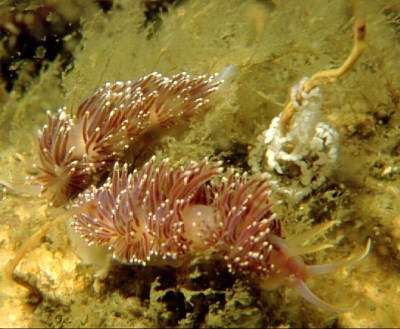
NOTE: Facelina coronata is a synonym of Facelina auriculata. See Bernard Picton's message. Until 30 August 2001 the name F. coronata was used on the Forum.
Dear Bill,
Here is a photo of Facelina coronata to add to the Netherlands' List.
Like the earlier photo I sent, it is also from Zierikzee (Zeelandbrug), de Oosterschelde, the Netherlands
With best regards
Peter H. van Bragt
Peter.vanBragt@ftn.hsbrabant.nl
van Bragt, P.H., 1999 (Aug 13) Facelina coronata from the Netherlands. [Message in] Sea Slug Forum. Australian Museum, Sydney. Available from http://www.seaslugforum.net/find/1171Re: Mystery from Holland
June 10, 1999
From: Peter H. van Bragt

NOTE: Facelina coronata is a synonym of Facelina auriculata. See Bernard Picton's message. Until 30 August 2001 the name F. coronata was used on the Forum.
Hallo Xavier,
In addition to a reply that I send on 09 June 1999:
Here is a picture of a Facelina coronata. This picture was made in April at the Zeelandbrug, Oosterschelde, the Netherlands.
I assume that you saw this species.
Greetings,
Peter H. van Bragt
peter.vanbragt@ftn.hsbrabant.nl
van Bragt, P.H., 1999 (Jun 10) Re: Mystery from Holland. [Message in] Sea Slug Forum. Australian Museum, Sydney. Available from http://www.seaslugforum.net/find/935June 17, 1999.
Dear Peter,
Now that I have returned from Sicily I have been going through the recent messages.
Thanks for your messages on Xavier's 'mystery'. Any other photos and observations on nudibranchs from your part of the world would be very welcome.
best wishes,
Bill Rudman.
Facelina coronata f rom Mediterranean France
June 5, 1999
From: Daniel L. Geiger


NOTE: Facelina coronata is a synonym of Facelina auriculata. See Bernard Picton's message. Until 30 August 2001 the name F. coronata was used on the Forum.
Dear Bill,
Here are two photos of mine of Facelina coronata.
Banyuls sur Mer, Mediterranean coast, France. 1992.
The two animals show how a change of food colour (in ceratal digestive gland) can change appearance.
Daniel L. Geiger.
Geiger, D.L., 1999 (Jun 5) Facelina coronata f rom Mediterranean France. [Message in] Sea Slug Forum. Australian Museum, Sydney. Available from http://www.seaslugforum.net/find/4855Thanks Daniel,
Bill Rudman
